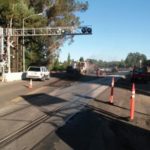- Company: Ghilotti Bros., Inc.
- Industry: Transportation
- Location: Saint Helena, California
- Expected Completion Date: 4/11/2017
- Project Website
This project added an approximate 6 mile one-lane two-way channelization lane on route 29 in Saint Helena, California. This project allows a more continuous flow of traffic by allowing cross traffic to wait for a break in oncoming traffic control. The previous condition caused massive backups while traffic waited for a break to cross to the other side. Residents, businesses, and tourists visiting vineyards and tasting rooms can now enjoy a free flowing commute. In addition, sidewalk and curb and gutter were placed thereby increasing the aesthetics in the business area and safety near the high school. A lighted crosswalk was also installed to create a safer crossing for students walking home. Further, this project implements a permanent stormwater run-off filtration in order to enhance the water quality in the nearby receiving waters.
What impact does this project have on America?
This project increases safety and reduces traffic congestion. The vintners and other local businesses will enjoy greater access and reduced transportation costs. Local residents can rest assured that their daily commutes will be shortened significantly. The high school students who drive, and who may not be the best drivers, now have an opportunity to exit the school area via the new traffic signal installed. I’m positive the traveling public has benefited from this safety measure. Though the State route is not a designated bike route, the increased four foot shoulder bike crossings at the railroad have made it safer for the competitive and recreational cyclist alike.
What interesting obstacles or unusual circumstances did you overcome to complete the project?
Temporary shutdowns due to grape harvest and wine auctions were interesting. But more interesting than that was the infiltration trench design. Caltrans is required to provide mitigation measures for every unit area of hardscape constructed. Due to the vineyards and businesses running on either side of highway, typical applications such as biofiltration swales were not applicable in this situation. The last resort was th infiltration trench design that had conflicts with underground utilities, HMA dike alignment, shoulder requirements. The use of Partnering on this project may have been the only tool that allowed the Team to overcome the issues and proceed with the work in a timely manner.
Since there was a previous project that put all utilities in the area underground there was, and is, massive coordination with AT&T and PG&T. There were approximately 10 AT&T and 20 PG&E vaults within the roadway that required changes to drainage courses, curb and gutter, coordination for raising each vault. Anyone who works with PG&E know they don’t generally work with you.
In addition, about a month prior to the Contractor starting the paving operation the DOT released a Memorandum changing the allowable amoutn of reclaimed asphalt concrete allowed in the mix. The operation was only affected by two days as the supplier, the Senior Construction Manager for Caltrans, and the Contractor were all able to work together and pave the road prior to the fall harvest shutdown requirements.
What dangers and risks did you encounter, and describe any extraordinary methods used to keep workers safe?
The Napa Valley Wine Train crosses the highway at a diagonal and runs parallel to the project. There are two trains that run north then back south every day. This established logistical and safety challenge throughout the project. Ghilotti Bros. safety policy is atop their values next to quality. In addition, the willingness of local law enforcement, the Owner (CDOT/Caltrans) to aid in additional message boards and notifications, and constant communication with the Wine Train allowed for a successfully safe project.
How did you leverage new technologies to work faster and reduce waste?
As referenced in a previous section, the project called for a maximum of 23% reclaimed asphalt concrete in the mix. Though the top lift was changed to a maximum of 15% RAP the other 13,000 tons were a quarter recycled material.










